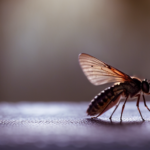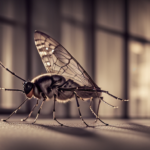Picture coming home and being welcomed by a flurry of small moths. While these creatures may appear harmless, their presence can be quite irritating.
In this article, I will delve into the world of these miniature insects to help you understand what they are and how to get rid of them.
Tiny moths in your house could belong to various species, each with its own unique characteristics. By identifying these moths, you can gain insight into their behavior and habits. Furthermore, understanding their life cycle is crucial in effectively eradicating them from your home.
Moth infestations can be caused by a variety of factors, such as improper food storage or poor sanitation practices. By addressing the root causes of infestations, you can prevent these pesky creatures from making your house their home.
This article will also explore natural remedies and chemical solutions to get rid of moths, as well as provide tips on cleaning and disinfecting your house after an infestation. By following these preventive measures and seeking professional help when needed, you can ensure a moth-free living space.
Key Takeaways
- Tiny moths in the house can cause infestations
- Moth infestations caused by improper food storage and poor sanitation
- Cleaning and vacuuming pantry eliminates eggs and larvae
- Regular inspections and monitoring prevent future moth infestations
Identifying the Types of Tiny Moths in Your House
If you’re wondering what those tiny moths in your house are, it’s important to identify the different types. Understanding their behavior and what attracts them can help you better deal with the infestation.
There are several common types of tiny moths that you may find in your house. The first type is the Indian meal moth. These moths are attracted to grains, flour, and other dry food products. They can infest your pantry and contaminate your food.
The second type is the clothes moth. These moths are attracted to natural fibers such as wool, silk, and fur. They can damage your clothing and fabrics.
To identify the type of moth you have, you can observe their behavior. Indian meal moths are usually found flying around your kitchen and pantry, while clothes moths are more likely to be found in your closets and storage areas.
Understanding the life cycle of moths is crucial in getting rid of them. By knowing how they reproduce and develop, you can target their vulnerable stages to eliminate them effectively. With this knowledge, you can take the necessary steps to control the moth population in your house.
Understanding the Life Cycle of Moths
The life cycle of moths is a fascinating process, with each stage having its own unique characteristics and duration. Understanding moth behavior and the different stages of their life cycle can help in managing and preventing moth infestations in your home.
Here are the four stages of a moth’s life cycle:
-
Egg: Moths start their life as tiny eggs, usually laid on a food source such as fabrics, carpets, or stored food. These eggs are often difficult to spot due to their small size and camouflage coloration.
-
Larva: Once the eggs hatch, they enter the larval stage, commonly known as caterpillars. These caterpillars are voracious eaters and can cause significant damage to fabrics, textiles, and stored food. They go through several molts, gradually growing larger and shedding their old skin.
-
Pupa: After the caterpillar reaches its full size, it enters the pupal stage. During this stage, the caterpillar spins a cocoon or forms a hard shell around itself. Inside the cocoon, the caterpillar undergoes metamorphosis, transforming into an adult moth.
-
Adult: Once the transformation is complete, the adult moth emerges from the cocoon. Adult moths have wings and are capable of flying. Their primary goal is to reproduce and continue the life cycle by laying eggs.
Understanding the life cycle of moths can provide insights into their behavior and help in identifying and addressing moth infestations in your home.
The next section will explore common causes of moth infestations in homes and how to prevent them.
Common Causes of Moth Infestations in Homes
One potential cause of moth infestations in residences is improper storage of fabrics or stored food. Moth larvae and eggs are commonly found in fabrics made of natural fibers such as wool, silk, or fur. These tiny creatures are attracted to the protein found in these materials, making them a perfect breeding ground for moths.
Improperly stored food items, such as grains, cereals, or pet food, can also attract moths. Moth eggs can be unknowingly brought into the house through infested food packages or clothing. Once inside, these eggs can hatch into larvae and start feeding on nearby fabrics or stored food.
To prevent moth infestations, it is important to store fabrics properly. This includes washing or dry cleaning them before storage, using airtight containers, and regularly inspecting stored items for signs of moth activity. When it comes to food, ensure that all packages are tightly sealed and stored in a cool, dry place. Regularly clean your pantry and vacuum any crumbs or spills that may attract moths.
By implementing these prevention tips, you can keep moths out of your house and protect your belongings from damage. Moving forward, let’s explore some effective ways to keep moths at bay.
Prevention Tips to Keep Moths Out of Your House
When it comes to preventing moth infestations in your house, there are several key points to keep in mind. First and foremost, proper food storage techniques are essential. This means sealing all food items in airtight containers and regularly checking for any signs of infestation.
Additionally, regular cleaning and vacuuming of your home is crucial in removing any potential moth eggs or larvae. Finally, securing entry points, such as cracks and crevices, and inspecting plants and flowers for any signs of moth activity can help prevent these pesky insects from entering your home.
Proper Food Storage Techniques
Properly storing food can be like building a fortress against tiny moths in your house. To effectively prevent moths from infesting your pantry, it is essential to have proper pantry organization and use effective moth traps. Here are some key techniques for proper food storage:
| Pantry Organization | Moth Traps | Regular Cleaning and Vacuuming | |
|---|---|---|---|
| 1 | Keep food in airtight containers to prevent moths from accessing them. | Place moth traps strategically throughout your pantry to catch any adult moths. | Regularly clean your pantry, wiping down shelves and vacuuming any crumbs or debris. |
By organizing your pantry and using moth traps, you can minimize the risk of moths infesting your food. However, it is also crucial to regularly clean and vacuum your pantry to ensure any potential moth eggs or larvae are eliminated. In the next section, we will discuss the importance of regular cleaning and vacuuming in further detail.
Regular Cleaning and Vacuuming
To effectively keep your pantry free from moth infestations, it’s important to regularly clean and vacuum, ensuring a pristine and pest-free environment. Maintaining a clean pantry not only helps to eliminate any existing moths but also prevents their return. Here are three key steps to follow for regular cleaning:
-
Remove all items from the pantry shelves, inspecting them closely for any signs of moth activity. Dispose of any infested products immediately.
-
Wipe down the shelves using a mixture of hot water and mild detergent. Pay extra attention to the corners and crevices where moths may hide.
-
Vacuum the pantry thoroughly, including the walls and ceiling. Use a brush attachment to reach into tight spaces.
Regular cleaning alone may not always be sufficient, especially in severe cases. In such instances, it may be necessary to seek professional pest control services. Once your pantry is clean, it’s time to move on to securing entry points and preventing a future infestation.
Securing Entry Points
Make sure you check for any small cracks or gaps in your pantry walls or shelves where sneaky moths could potentially find their way in. These tiny moths have a knack for squeezing through the tiniest openings, so it’s crucial to secure all possible entry points.
Start by inspecting your windows and make sure they’re properly sealed. Look for any cracks or gaps around the frames and use caulk or weatherstripping to seal them.
Additionally, check your doors for any openings and install door sweeps if necessary. By taking these measures, you can significantly reduce the chances of moths finding their way into your home.
Now, let’s move on to the next step of inspecting plants and flowers for any signs of infestation.
Inspecting Plants and Flowers
Now that we’ve secured the entry points, let’s turn our attention to inspecting plants and flowers in our homes. Indoor plants can often be a breeding ground for tiny moths, so it’s important to closely examine them for any signs of plant pests.
Start by carefully checking the leaves, stems, and flowers for small holes or discoloration, as these can indicate the presence of moth larvae. Look for any webbing or silk-like material, as this is a common sign of infestation. Additionally, inspect the soil for any signs of eggs or larvae.
Remember to pay special attention to plants that are near windows or doors, as these are more likely to attract moths. By thoroughly inspecting your indoor plants, you can identify any potential infestations and take appropriate action to eliminate them.
Moving forward, let’s explore natural remedies to get rid of moths.
Natural Remedies to Get Rid of Moths
When it comes to getting rid of moths naturally, there are several remedies that can be effective. One option is to use lavender and cedar, which are both known for their strong scent that repels moths.
Another option is to use a combination of cloves and bay leaves, as their strong odor can also deter moths.
Additionally, a vinegar and water solution can be sprayed on infested areas to kill and repel moths, while freezing infested items can also help eliminate any larvae or eggs present.
Lavender and Cedar
To keep those tiny moths out of your house, try using lavender and cedar. These natural moth repellents can be effective alternative moth control methods.
Lavender has a strong scent that moths find unpleasant, making it an excellent deterrent. You can use lavender essential oil or dried lavender sachets to repel moths from your closets, drawers, and other areas where they may be hiding.
Cedar, on the other hand, contains natural oils that repel moths and other insects. Cedar blocks or chips can be placed in your wardrobe or drawers to keep moths away.
The combination of lavender and cedar creates a powerful barrier against moths, helping to protect your clothes and belongings.
Now, let’s explore another natural remedy for moths: cloves and bay leaves.
Cloves and Bay Leaves
If you’re looking for a natural way to repel those pesky insects, cloves and bay leaves can act as a strong barrier, just like a fortress protecting your clothes and belongings.
Cloves have numerous benefits when it comes to warding off moths. Their strong aroma is highly effective in keeping these tiny creatures at bay. Additionally, cloves contain natural insecticidal properties that can eliminate moth larvae and eggs.
Bay leaves, on the other hand, have been used for centuries for their insect-repelling qualities. They release a powerful scent that moths find unpleasant, making them reluctant to invade your home.
Incorporating cloves and bay leaves into your moth prevention strategy is a simple and effective way to keep these pests away.
Now, let’s move on to another natural solution: a vinegar and water solution that can help eliminate moths.
Vinegar and Water Solution
Ready to tackle those pesky insects invading your space? Try out a vinegar and water solution – it’s a natural and effective way to bid farewell to those unwanted guests.
Vinegar, a common household ingredient, contains acetic acid, which is known to repel moths and other insects. To make the solution, simply mix equal parts of vinegar and water in a spray bottle. Shake well and then spray the solution in areas where you’ve noticed the tiny moths. Pay close attention to corners, cracks, and crevices where they like to hide.
Additionally, you can add a teaspoon of baking soda to the mixture for added effectiveness. The combination of vinegar and baking soda creates a powerful repellent that will help keep those pesky moths at bay.
Now, let’s move on to the next step – freezing infested items.
Freezing Infested Items
One effective way to combat these unwelcome guests is by freezing infested items. Freezing techniques can be a powerful weapon against tiny moths in your house. Here are four reasons why freezing is an effective method:
-
Temperature shock: Freezing items infested with moths causes a sudden drop in temperature, which can kill the larvae, eggs, and adult moths.
-
Longevity of effects: Once frozen, the items remain protected for an extended period, preventing reinfestation.
-
No chemicals: Freezing is a chemical-free method, making it safe for both humans and pets.
-
Cost-effective: Freezing requires minimal resources and can be done easily at home.
In addition to freezing, there are homemade moth repellents that can be used to further enhance the effectiveness of your moth control efforts. These natural solutions can be a great alternative to chemical solutions.
Transitioning into the subsequent section, chemical solutions for moth control provide an alternative approach to tackling this persistent problem.
Chemical Solutions for Moth Control
To effectively control the tiny moths in your house, you should consider using chemical solutions. While natural moth repellents and homemade moth traps can be effective to some extent, chemical solutions offer a more targeted and potent approach to moth control.
There are several types of chemical solutions available in the market that are specifically designed to eliminate moths and prevent reinfestation.
One commonly used chemical solution is moth foggers or bombs. These products release a fine mist of insecticide that fills the entire room, reaching even the most hidden corners where moths might be hiding.
Another option is moth sprays, which can be used to directly target moths and their larvae on surfaces such as furniture, carpets, and curtains. These sprays typically contain pyrethroids or pyrethrins, which are known to be effective against moths.
It is important to carefully follow the instructions provided with these chemical solutions to ensure safe and effective use. Additionally, it’s recommended to wear protective clothing, such as gloves and a mask, when applying these chemicals to minimize exposure.
Once you’ve successfully controlled the moth infestation using chemical solutions, the next step is to clean and disinfect your house to remove any remaining eggs or larvae.
Cleaning and Disinfecting Your House after Moth Infestation
After successfully eliminating the moths in your house using chemical solutions, it’s essential to thoroughly clean and disinfect your home to ensure that any remaining eggs or larvae are eradicated. Cleaning techniques play a crucial role in preventing future infestations and maintaining a moth-free environment.
Firstly, remove all clothing and linens from the affected areas and wash them in hot water to kill any remaining eggs or larvae. Vacuum all carpets, rugs, and upholstery to remove any moth eggs or larvae that may be hiding in the fibers. Pay close attention to corners, cracks, and crevices where moths may lay their eggs.
Next, disinfect your home using natural repellents such as cedar chips or sachets, lavender oil, or eucalyptus leaves. These natural repellents not only deter moths but also leave your home smelling fresh and pleasant. Place them in closets, drawers, and other moth-prone areas to keep the pests at bay.
Lastly, regularly monitor your home for any signs of moth infestation and take preventive measures to avoid future problems. By implementing these cleaning techniques and using natural repellents, you can create an environment that’s unappealing to moths and reduce the risk of future infestations.
Now, let’s explore effective ways to monitor and prevent future moth infestations.
Monitoring and Preventing Future Moth Infestations
When it comes to preventing future moth infestations, there are a few key points to keep in mind. Regular inspections of your home are essential to catch any signs of moths early on.
Maintaining cleanliness is crucial, as moths are attracted to dirty and cluttered areas.
It’s also important to monitor food storage areas, as moths are often drawn to pantry items.
Finally, implementing outdoor prevention measures, such as sealing cracks and gaps, can help keep moths from entering your home in the first place.
Regular Inspections
Make sure you’re regularly inspecting your house for any signs of tiny moths – could they be hiding in your closet or pantry? Regular maintenance is crucial in preventing moth infestations.
Here are three important reasons why regular inspections are necessary:
-
Early Detection: By inspecting your house regularly, you can catch any signs of moth infestations at an early stage. This allows you to take immediate action and prevent the problem from escalating.
-
Identifying Vulnerabilities: Regular inspections help you identify any vulnerabilities in your house that may attract moths, such as cracks in walls or improperly sealed containers. By addressing these issues promptly, you can minimize the chances of a moth infestation.
-
Peace of Mind: Regular inspections provide peace of mind, knowing that you are actively monitoring your house for any signs of tiny moths. This proactive approach helps maintain a clean and moth-free environment.
Maintaining cleanliness is another essential aspect in preventing moth infestations.
Maintaining Cleanliness
To prevent infestations, it’s crucial for you to keep your living space clean and tidy. Regularly cleaning your house not only reduces the risk of moth infestation but also promotes a healthy and hygienic environment. Creating a cleaning schedule can help you stay organized and ensure that all areas are thoroughly cleaned. Additionally, incorporating natural moth repellents can provide an extra layer of protection. Some effective natural repellents include lavender, cedar, and cloves. These substances emit scents that moths find unpleasant, deterring them from entering your home. By implementing a cleaning schedule and using natural moth repellents, you can significantly reduce the chances of a moth infestation. Transitioning into the next section, it’s important to also monitor food storage areas to prevent moth larvae from contaminating your pantry.
Monitoring Food Storage Areas
By regularly monitoring the cleanliness of your food storage areas, you can effectively prevent the contamination of pantry items by moth larvae. Monitoring the pest population in these areas is crucial for early detection of any infestations.
One way to do this is by setting up moth traps specifically designed to attract and capture adult moths. These traps can be placed near food storage areas and should be checked regularly for any signs of moth activity.
Additionally, inspecting food packages for any holes or signs of moth larvae can help identify potential infestations. If any moths are detected, it’s important to take immediate action to eliminate them and prevent further spread.
By implementing these monitoring and detection methods, you can ensure the safety and quality of your pantry items.
Transitioning into outdoor prevention measures, it’s also important to take steps to prevent moths from entering your home in the first place.
Outdoor Prevention Measures
Take a proactive approach to safeguarding your home from unwanted moth visitors by implementing outdoor prevention measures. Here are three effective strategies to keep moths away from your house:
-
Install outdoor lighting with yellow or pink bulbs: Moths are attracted to bright white lights, so using bulbs with warmer colors can deter them from congregating near your home.
-
Plant moth-repelling plants: Certain plants, such as lavender, rosemary, and mint, have natural scents that repel moths. Planting these around your outdoor living areas can help keep moths at bay.
-
Keep your yard tidy: Moths are attracted to clutter and overgrown vegetation. Regularly trim bushes, mow the lawn, and remove any debris or leaf piles that may provide hiding spots for moths.
By following these outdoor prevention measures, you can significantly reduce the chances of moth infestations in your home. If you’re dealing with a severe infestation, it may be necessary to seek professional help.
Seeking Professional Help for Severe Infestations
When dealing with a severe moth infestation in my house, it’s important to be aware of the signs that indicate the severity of the problem. These signs may include an overwhelming number of moths, extensive damage to clothes and fabrics, and the presence of moth larvae and eggs.
In such cases, seeking professional help for extermination is highly recommended, as they have the expertise and resources to effectively eliminate the infestation. Finding a reliable pest control company is crucial, as they can provide a tailored approach to address the specific needs of my home.
Additionally, they can offer long-term prevention strategies to ensure that the moths don’t return in the future.
Signs of a Severe Infestation
Amidst the fluttering dance of these minuscule nocturnal creatures, your house becomes a secret haven for a serious moth invasion. Signs of a severe infestation include an overwhelming number of moths, especially in areas where they congregate such as closets or pantry shelves.
You may also notice moth larvae or cocoons, indicating a thriving population. Damage to clothing, curtains, or stored food is another clear indication of a severe infestation. It’s crucial to address this issue promptly to avoid further damage and potential health risks.
Seeking professional help for extermination offers numerous benefits. Expert technicians can accurately assess the severity of the infestation and implement targeted treatments to eradicate the moths effectively. Additionally, professional extermination services provide long-term solutions and preventive measures to ensure the elimination of these pesky invaders.
Transitioning into the subsequent section, understanding the benefits of professional extermination is essential in dealing with this persistent problem.
Benefits of Professional Extermination
After learning about the signs of a severe moth infestation, it became clear that I needed to take immediate action. However, instead of resorting to professional extermination right away, I decided to explore the benefits of DIY methods and eco-friendly options.
One of the main advantages of DIY methods is the cost-effectiveness. By using homemade traps and natural repellents, I could potentially save money while still effectively eliminating the moths.
Additionally, eco-friendly extermination options provide a sustainable approach that minimizes harm to the environment. Utilizing natural ingredients and non-toxic substances ensures the safety of both my family and the ecosystem.
However, if my DIY efforts fall short, I will have to consider finding a reliable pest control company.
Finding a Reliable Pest Control Company
To ensure a stress-free experience, you should start by researching and comparing different pest control companies in your area. Finding reputable pest control companies is essential to address the issue of tiny moths in your house effectively. When comparing different pest control methods, it is important to consider factors such as the type of pests being targeted, the severity of the infestation, and the potential risks and benefits of each method. To assist you in your research, I have provided a table below that compares three common pest control methods: chemical control, biological control, and physical control.
| Pest Control Method | Description |
|---|---|
| Chemical Control | Involves the use of pesticides or insecticides to eliminate pests. It is effective but may pose risks to human health and the environment. |
| Biological Control | Utilizes natural predators, parasites, or pathogens to control pests. It is eco-friendly but may require time for the predators to establish and may not be effective against all pests. |
| Physical Control | Relies on physical barriers, traps, or mechanical methods to prevent or remove pests. It is safe and environmentally friendly but may not be as effective against large infestations. |
By comparing different pest control methods, you can make an informed decision on the most suitable approach for addressing the tiny moth issue. Now, let’s explore long-term prevention strategies.
Long-Term Prevention Strategies
To ensure you never have to deal with these pesky critters again, let’s explore some long-term prevention strategies.
One of the most effective and cost-effective solutions is to eliminate their food sources. Store all pantry items, including grains and pet food, in airtight containers. Regularly clean and vacuum your house to remove any potential food debris.
Additionally, sealing cracks and openings in your home’s foundation and windows can prevent moths from entering. Another natural alternative is to use essential oils, such as lavender or cedar, which have repellent properties. Placing sachets or cotton balls soaked in these oils in problem areas can deter moths.
Finally, consider installing screens on windows and doors to prevent these insects from entering your home.
By implementing these long-term prevention strategies, you can effectively keep those tiny moths at bay.
Frequently Asked Questions
How long do moths typically live?
Moths typically live for a few weeks to several months, depending on various factors. The average lifespan of a moth is around 2-4 weeks, but this can be influenced by factors like species, environment, and availability of food sources.
Can moths cause damage to clothing and fabrics?
Moths can indeed cause damage to clothing and fabrics. To prevent this, I recommend using natural moth repellents such as cedar chips, lavender sachets, or storing clothes in airtight containers.
Are all types of moths attracted to light?
Moth behavior at night varies. While many moths are attracted to light, not all exhibit the same level of attraction. Other factors, such as pheromones, scent, and temperature, can also attract moths.
Do moths only infest homes or can they be found in other places?
Moths are not limited to infesting homes. They can also be found in gardens, where they may cause damage to plants. To prevent infestations in homes, ensure proper sealing of windows and doors, use moth repellents, and regularly clean and vacuum.
Can moths transmit diseases to humans or pets?
Moths can transmit diseases to humans and pets through their larvae, feces, and scales. Moth borne diseases can cause allergies, respiratory issues, and skin irritations. Infestations pose health risks and should be addressed promptly.
Conclusion
In conclusion, dealing with tiny moths in your house can be a frustrating experience. However, by identifying the types of moths and understanding their life cycle, you can effectively control and prevent infestations. You can use natural remedies and chemical solutions to get rid of moths. Additionally, cleaning and disinfecting your house is crucial after an infestation. By monitoring and seeking professional help if needed, you can ensure a moth-free home. Remember, just like a skilled entomologist, you have the power to keep these pesky moths at bay.
Hi, I’m Emma. I’m the Editor in Chief of Tiny House 43, a blog all about tiny houses. While tree houses are often associated with childhood, they can be the perfect adult retreat. They offer a cozy space to relax and unwind, surrounded by nature. And since they’re typically built on stilts or raised platforms, they offer stunning views that traditional homes simply can’t match. If you’re looking for a unique and romantic getaway, a tree house tiny house might just be the perfect option.
















